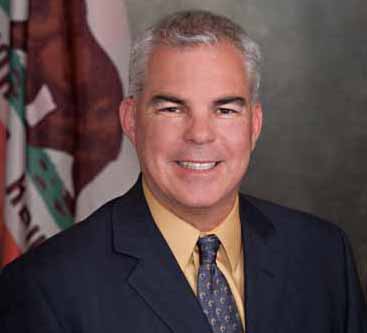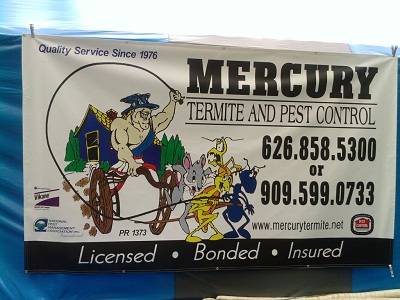
| August 2012 | Past Issues | Printer-Friendly | Advertise | Affiliates Search | Find a Pest Control Operator | PCOC.org |
|
EVP NOTES
The summer of 2012 will be remembered as the summer of bankruptcies. At least three California cities have declared bankruptcy. Several others, and there are new ones announced it seems every month, are concerned enough to discuss bankruptcy, including the two largest: Los Angeles and San Diego. Elected officials and local city managers succumbed to local political pressure from their employee unions. They committed their cities to outrageous spending in salaries and fringe benefits, especially pensions and health care, as well as unchecked spending on civic improvements that could not be sustained when the housing crisis hit and revenue declined. The bad news doesn't stop there. For years, governors and legislators have spent brief revenue windfalls on permanent spending and also on tax cuts. They have passed budgets based on whimsy, ignored liabilities including pensions and retiree health care, and covered resulting deficits with ever more elaborate accounting tricks and borrowing. It is amazing that voters have watched all of this go on for many years and not exercised their rights and replaced their elected officials. Individuals are used to balancing their household budgets: when you don't have the money, you don't spend it. More importantly, small business owners, PCOC members, look at what is going on at the state and local government level and get very angry. Quite rightly. Small businesses have to operate on a budget. Small business owners on Fridays worry about whether there is enough money to meet the payroll. If there isn't enough money coming in, they cut...not spend. Our government entities in this state can learn a lot from the example that the private sector sets. It is up to each one of us to let our elected politicians know how the real world works! By Brian R. Leahy
Protecting surface water from pesticide contamination in urban runoff is the intent of the Department of Pesticide Regulation's (DPR) new restrictions on businesses that provide structural pest control, effective July 19. These landmark regulations are the first of their kind in California to protect water quality from structural pest control applications. Pest control businesses and maintenance gardeners apply more than 70 percent of the pyrethroids targeted by the new rules. The restrictions cover 17 pyrethroid insecticides. In addition to decreasing the amount of insecticides used, the regulations prohibit pest control applicators and maintenance gardeners from making applications when it rains, when puddles are present and over drains and natural drainage areas. The regulations reflect changes suggested by our stakeholders during a series of workshops and meetings over the past two years. We appreciate the support of the Pest Control Operators of California as we developed the regulations and recognize that many businesses were already following these practices. We're enthusiastic about an online educational video on the new regulations being produced by the Pyrethroid Working Group to help pest control professionals better understand the new requirements. The group is an alliance of companies that manufacture pyrethroid insecticides and is working together to address a wide range of issues specific to pyrethroids. A DPR senior environmental scientist in our Enforcement Branch observed the video shoot to ensure its accuracy. The video features Jim Steed, owner of Neighborly Pest Management in Sacramento, and applicator Erik Jacobson who volunteered their time and expertise. The video will be posted soon on the group's website - click here. Our new regulations are generally equivalent to the U.S. Environmental Protection Agency's new label requirements, but are more restrictive in the following situations: · Perimeter treatments can only be made up to two feet from the base level of vertical structures (versus three feet on the label) and only out to three feet from the base of a structure on horizontal soil and other soft surfaces (no label restrictions). · Broadcast treatments cannot be made within two feet of horizontal impervious surfaces. The pyrethroids being restricted are bifenthrin, bioallethrin, S-bioallethrin, cyfluthrin, beta-cyfluthrin, gamma-cyhalothrin, lambda-cyhalothrin, cypermethrin, deltamethrin, esfenvalerate, fenpropathrin, tau-fluvalinate, permethrin, phenothrin, prallethrin, resmethrin and tetramethrin. The regulations were prompted by surface water monitoring data which indicated that pesticides were exceeding levels toxic to some small aquatic organisms. We are optimistic that the restrictions will result in a significant reduction in pesticide runoff into our urban waterways. Brian R. Leahy is director of the California Department of Pesticide Regulation. FROM THE DESK OF THE PRESIDENT, SCOTT HOWELL
As we approach our first Board Meeting of the year in Monterey (Sept. 28-29), I want to reach out to every member to let you know what our committees are working on. There is a lot going on and there are many ways to become involved. Here is just a snippet of what is going on in the standing committees. As PCOC members, you are invited to attend these meetings and if you are so inclined, ask the chair to appoint you as a member to their committee. The Termite Committee will be working with the Fumigation Committee on some key issues. One will be to create a checklist for Branch 3 operators to ensure their subcontract fumigators are complying with CAP and all other regulations. Another is to draft a "what to look for" tip list that can be provided to local law enforcement so they can help put a stop to the break-ins that are occurring on fumigations. They will also be working with Cal OSHA consultants to help Branch 3 companies develop their own Fall Protection Plan. The chair for this year is Mike McKenzie. The Fumigation Committee will work closely with the Termite Committee to create the fumigator compliance checklist and the tip list for law enforcement. This committee will also continue their work on Fall Protection, as it applies to Branch 1 companies. Additonally, they will continue their usual role in tackling the constantly changing regulations facing fumigators, working very closely with the Fumigation Enforcement Committee. The chair for this year is Victor Tinoco. The Fumigation Enforcement Committee will continue their critical role of bringing together DPR, the Structural Pest Control Board, County Agricultural Departments, fumigant registrants, distributors and Branch 1 operators to fine tune and focus the efforts in fumigation regulatory enforcement. The challenges on the horizon for this committee are the reworking of the CAP document and continuing the effort to upgrade the enforcement program so that it is as effective as possible in creating and maintaining that level playing field for all Branch 1 companies. John Sansone will return as chair for the upcoming year. The General Pest Committee will continue its focus on rodenticide issues as well as assisting all member companies in seamlessly integrating the new water quality standards into their daily practice. This committee will also be working with Cal OSHA consultants to develop Fall Protection plans specific to Branch 2 work. The chair for this year is Dave Harmon. The Membership Committee will be striving to create new and exciting offers for non-members to entice them to join, while at the same time increasing the value of membership for all of us. Josh Adams will be working very closely with this committee so that great ideas can become reality. If you want to help create more value for all of us and want to see PCOC's membership numbers grow, this is the place for you. The chair for this year is Terri Bacchetti. The Media Committee is truly on the cutting edge of what is happening at PCOC. Under Jim Steed's visionary leadership, this committee is working on enhancing our website so that we get even more "bang for our buck" while also developing webinars for members and plugging us in with the media tools that are available at NPMA. This innovative group is also in the process of producing our own Public Service Announcements, establishing a Facebook page (for PCOC and for each district) and training those who wish to work with the media to promote what we do as an organization. Jim Steed will be the chair again this year. The Affiliate Committee is open to all affiliate members. They focus on putting all of the pieces together for the exhibit hall at our Expo, while also reaching out to other companies to join PCOC and enjoy the benefits of an affiliate membership. As the Membership Committee continues to search for new vendors who will bring special deals and member-only programs to us, the Affiliate Committee will add them as members and bring those new vendors into the fold. Nate Tamialis will be chairing this committee. The Convention Steering Committee's main function is to research and find exciting and high-value locations for our upcoming Expo events. After researching everything from meeting room space to local amenities and maximum value for the price, this committee then presents the finalists to the Board for a vote on where the Expo will ultimately take place. This group also works closely with the Affiliate Committee to work out the logistics of the exhibit hall so that we get the most for our money. Joe Gatto will be heading up this committee. The Legislative Committee has a very full plate these days. This committee works closely with the elected trustees of PAPCO and with Dominic DiMare, our Legislative Advocate, to develop our responses to legislation that affects our industry. They also are an integral part of our annual Legislative Day event, possibly one of our most exciting events of the year. If you have a political bone in your body, this is the committee for you. The chair for this year is Darrel Ennes. The Constitution and Bylaws Committee will have a busy agenda this year. I have asked the returning chairman, Scott Heinkel, to put together a committee dedicated to vetting the new and exciting ideas designed to enhance and reinvigorate the membership of PCOC. There are many notions floating around about how to do this and I am sure many of you have an opinion about them – perhaps you have an idea of your own that deserves to be heard. Whether it is reducing the number of directors, or combining our quarterly Board meetings with other events (e.g., Legislative Day, Fumigation School or Leadership Academy), these ideas will all be vetted here first before making it to the Board for an up or down vote if they require a change in our bylaws. The function of the Ethics Committee is to hold closed meetings to discuss ethics complaints made against PCOC members and to manage the ethics complaint process outlined in our bylaws. While the meetings are restricted to those on the committee, the members will be appointed by the chair. If you have an interest in being on this committee, contact the incoming chairman, Dan Prechtl. There is a lot going on at PCOC this year. I encourage all of you to attend the upcoming committee meetings in Monterey on Sept. 28. To those of you who have been and continue to be involved, I thank you and I ask you to continue to keep that flame burning. For those who have never been involved, please come and join us – we need to hear your voice and depend on your involvement so that PCOC can reach its true potential. LEGISLATIVE UPDATE
IN THE NEWS
 When filling out Monthly Summary Pesticide Use Reports, many pest control operators in California only fill out the total number of applications for Restricted Use Materials and category 1 pesticides, excluding category 2 and 3 pesticides. This practice is in following with enforcement letter 90-13 issued in January of 1990 (see below – pertinent areas are italicized, bold and underlined). When filling out Monthly Summary Pesticide Use Reports, many pest control operators in California only fill out the total number of applications for Restricted Use Materials and category 1 pesticides, excluding category 2 and 3 pesticides. This practice is in following with enforcement letter 90-13 issued in January of 1990 (see below – pertinent areas are italicized, bold and underlined).ENF 90-13 (Enforcement Letter) Jan. 12 ,1990: To: County Agricultural Commissioners Subject: 100% Pesticide Use Reporting (Policy Letter No. 5) Recent meetings between the Pesticide Use Enforcement Branch, Worker Health and Safety Branch (WH&S) and the Pest Control Operators of California (PCOC) have resulted in the following agreement and policy (attached): - Structural Pest Control Operators (SPCO) will continue to complete the Total Number of Applications Box. (Located at the top of the Monthly Summary Pesticide Use Report.) - SPCOs will continue to identify the number of applications for each restricted and category 1 pesticide(s) applied (Located in column D of the Month Summary Pesticide Use Report.) - SPCOs will not be required to identify the number of applications for each non-restricted category 2 and 3 pesticide applied (Located in column D of the Monthly Summary Pesticide Use Report.) PCOC has agreed to the requirements of this policy which are a stricter standard than the new use reporting requirements. Under the terms of the policy PCOC in co-operation with WH&S will conduct actual studies of exposure to workers. These studies are expected to provide information in greater detail than could otherwise be obtained through the requirements of California Code of Regulations Section 6627. Therefore, the Department is rescinding the statement in ENF Letter 89-75 that states in part: "require that all monthly pesticide reports include the number of applications for each type of pesticide applied." Please continue to refer to ENF Letter 89-75 to assist you in determining the toxicity category and restricted use status of pesticide(s) listed on the Monthly Summary Pesticide Use Report. The listing provides the names, toxicity categories and restricted use status. However, the Department of Pesticide Regulation is looking into requiring SPCB-registered companies to comply with the Structural Pest Control Act 8505.17. (see below) From the Structural Pest Control Act: 8505.17. (c) Registered structural pest control companies shall prepare and submit to the county agricultural commissioner a monthly report of all pesticides used in that county. The report shall be on a form approved by the Director of Pesticide Regulation and shall contain the name and registration number of each pesticide, the amount used and the number of applications made. The report shall be submitted to the commissioner by the 10th day of the month following the month of application. Each pesticide use report or combination of use reports representing a registered structural pest control company's total county pesticide use for the month shall have affixed thereto a pesticide use stamp issued by the board in the denomination fixed by the board in accordance with Section 8674 as the pesticide use report filing fee. The board shall provide for the sale of these stamps and for the refund of moneys paid for stamps which are returned to it unused. When a registered structural pest control company performs no pest control during a month in a county in which it has given notice pursuant to Section 15204 of the Food and Agricultural Code, the registered company shall submit a use report stating this fact to the commissioner. No pesticide use stamp is required on negative use reports. This shift in policy will require all companies throughout California to put the number of applications for all pesticides no matter what the category into their monthly summaries. This will also allow DPR to better track pesticide usage throughout California. A few counties in California have already started adopting this practice. Companies that file electronically should make sure their software allows for tracking pesticide usage in all categories just to be ready in case the change is implemented. If and when this modification will happen is uncertain at this time. Representatives of PCOC have been conversing with DPR on the matter. INACCURATE PESTICIDE USE REPORTING The pest control industry is being scrutinized by government agencies, activist groups, media and the public. With environmental and water quality concerns, the industry needs to be careful now more than ever. One such area of scrutiny is accurate reporting of pesticide usage. In recent years, there has been an over-reporting of usage compared to materials actually purchased. This over-reporting reflects badly upon PCOs. Steps you can take to improve accuracy: - Ensure that all customer accounts are identified with their counties. - Have service technicians report daily pesticide uses in each county in which they make applications. - Ensure applicators make accurate measurements of amount applied (not approximations). - Fill out service reports after applications are made. - Report amount of concentrate used, not finished solution. - Ensure unit of measurement is consistent with package. - Report the smallest amount that can be measured. Accurate Inventory Management - Have one person responsible for issuing material and documenting distribution. - Take inventory monthly including storage area(s) and service vehicle(s). - Take accurate measurements of partially filled containers. - Make sure all materials are accounted for. - Compare ending inventory with beginning inventory in both the storage at the business and on the service vehicles. FUMIGATION COMPANIES COMPETE IN NINTH ANNUAL BANNER CONTEST
Mercury Termite and Pest Control Announced as 2012 Winner
INDIANAPOLIS — Aug. 6, 2012 — The Pest Control Operators of California (PCOC) and Dow AgroSciences, the manufacturer of VIKANE® gas fumigant, are pleased to announce the winners of the ninth annual Fumigation Banner Bonanza Contest. The contest recognizes California fumigators for promoting fumigation through easy-to-read, professional and creative signs at fumigation sites. This year's first-place prize was awarded to Mercury Termite and Pest Control of Covina, Calif. The winning banner features a cartoon drawing of different pests, as well as the logos for VIKANE and National Pest Management Association (NPMA). The banner has been in use for about two months, and the artwork on it was commissioned about 20 years ago. Owner Dan Rutherford says he and his staff are thrilled Mercury Termite and Pest Control won the contest. "It's fantastic," he says. "I have entered this contest before, but never won. I'm really happy about it." Judges commented that the banner was creative and eye-catching, and they appreciated the use of the logos for VIKANE and NPMA. Rutherford says he feels it's important to have the VIKANE logo on his company's banner. "I only use VIKANE. That's all I have ever used for about 25 years," he says. "When I tell people there are companies that use other fumigants, I make it a point to state that VIKANE has been manufactured for more than 50 years. If I have issues on a job, I know who to contact. That information is important to me, and the customers have a good response to that." Finishing in second place was Thrasher Termite and Pest Control of Los Gatos, Calif. Taking third was a banner from Suncrest Exterminating in Anaheim, Calif. Borite Termite and Pest Treatments, based in Sherman Oaks, Calif., earned fourth place. Participating fumigation companies submitted color photos of their banners, which included their business name, logo and contact information. A panel of communication specialists judged the banners on readability from a distance, professionalism, visual impact and attractiveness. Pest control companies with the winning banners will be given prizes in the following amounts: first place, $1,250; second, $1,000; third, $500; and fourth, $250. "We're happy to again have the opportunity to sponsor PCOC's contest as a way to help our fumigator partners build their businesses and promote industry efforts to educate homeowners on the need for professional fumigation services," says Justin Stewart, Dow AgroSciences product manager for VIKANE® gas fumigant. For more information about fumigation with VIKANE, click here.
®Trademark of Dow AgroSciences LLC
Vikane is a federally Restricted Use Pesticide.
Always read and follow label directions.
Photo Caption: This year's first-place banner was submitted by Mercury Termite and Pest Control of Covina, Calif.
ANNUAL BED BUG EXPERT CERTIFICATION PROGRAM Sept. 20, 2012 – California State University, Sacramento Being recognized as an expert in the field of bed bug management is critical for you and your company's ongoing success. And now you can be certified in the Pest Management industry. PCOC is proud to support Domus Institute, developed by Gail Getty, an independent scientific organization. Domus Institute's Professional Certification Program is a program designed to educate and train individuals in bed bug identification and eradication using industry standards and best practices. Domus Institute is holding a one-day training program for certification in Northern California on Sept. 20. Domus Institute is partnering with experts in research entomology, pathology, statistical algorithms and consumer insights and behaviors. Speakers include Gail Getty and William K. Reisen, PhD. Space is limited. For more information on this certification program and a brochure, click: http://www.domusinstitute.com/events.html. UPCOMING EVENTS
2012
Sept. 28-29
Board of Directors Meeting
Hyatt Regency
Monterey, CA
Oct. 2
18th Annual Tri-District Golf Tournament
Benefiting PAPCO
Coyote Hills Golf Course
Fullerton, CA
Dec. 7-8
Board of Directors Meeting
Hilton Palm Springs
Palm Springs, CA
2013
March 22-23
Board of Directors Meeting
Grand California Resort
Anaheim, CA
April 23-24
Legislative Days
Hyatt Regency Hotel
Sacramento, CA
May 30-31
Leadership Academy
Catamaran Resort Hotel
San Diego, CA
June 27-29
PCOC Expo 2013
Hyatt Vineyard Creek Hotel
Santa Rosa, CA
Sept. 27-28
Board of Directors Meeting
Catamaran Resort Hotel
San Diego, CA
Dec. 6-7
Board of Directors Meeting
Holiday Inn Golden Gateway Hotel
San Francisco, CA
MEMBER VALUE PROGRAM
NEW MEMBERS
FREQUENTLY REQUESTED INFORMATION
NPMA LOGIN FOR JOINT MEMBERSHIP LOGIN: 313501 PASSWORD: PCOC PCOC website password for 2012-2013 effective July 1, 2012: "killbugs"
Department of Fish & Game Department of Food & Agriculture Department of Pesticide Regulation Find Your Legislator Healthy Schools Act Structural Pest Control Board |
Pest Control Operators of California |
 |





